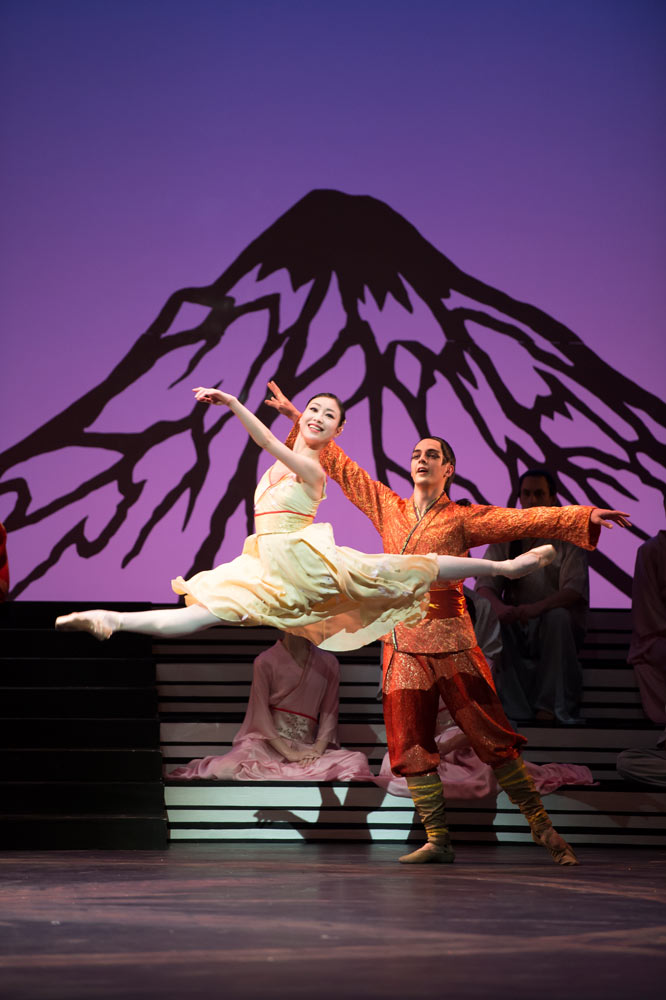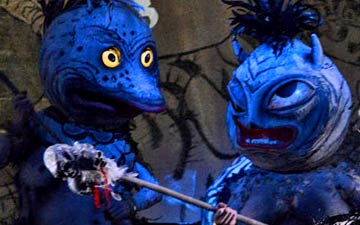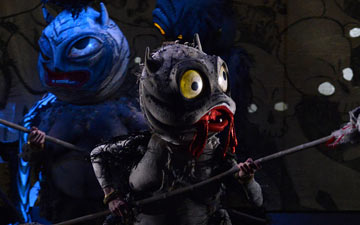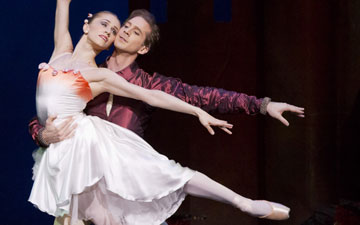
© Bill Cooper. (Click image for larger version)
Birmingham Royal Ballet
The Prince of the Pagodas
London, Coliseum
26 March 2014
www.brb.org.uk
David Bintley presents The Prince of the Pagodas as an oriental fable, set in an imperial past. He created it for the National Ballet of Japan in 2011, drawing on Japanese legends and woodcut illustrations while observing classical ballet conventions. His version is the opposite of the original scenario, devised by John Cranko in 1956/7, which conflated rather too many Western tales – Cinderella, Beauty and the Beast, The Sleeping Beauty, King Lear, Cymbeline – with a touch of the orient for the Kingdom of the Pagodas.
Benjamin Britten contrasted and combined east and west in his score, with his account of a Balinese gamelan orchestra representing the mysterious salamander prince. As played by the Royal Ballet Sinfonia, conducted by Koen Kessels, the music sounds suitably exotic to Western ears, describing the heroine’s adventures in the first two acts almost like a film score. But Britten oversupplied the last act, resulting in BRB’s audiences applauding the assumed end long before the grand pas de deux and finale. Since this happens on tour as well as in London, Bintley has been trapped into miscalculating the interminable happy-ending celebrations.

© Bill Cooper. (Click image for larger version)
His ballet opens with an intriguing prologue, setting up the story without giving the plot away. Rae Smith’s costume designs in Act I for the courtiers of the Chrysanthemum Throne depict a formal hierarchy about to be challenged by change. Four foreigners arrive to seek the hand of the Emperor’s daughter, Belle Sakura. Since their gifts are clearly unsuitable for a young girl, they are laying siege to her father’s empire. The Russian brings a model of an oil well, the African an elephant’s tusk, the Chinese an opium pipe and the American a case of rifles. Their solos reflect their ‘national’ stereotypes in 19th century ballet fashion: energetically danced but a laboured response to their musical signatures.
The choreography introducing Sakura (Momoko Hirata on the opening night) recalls Ashton’s innocent Chloe, about to be abducted. The fifth arrival, the snake-like salamander (Joseph Caley) who runs off with her, is in fact her brother, believed to be dead. He and his entourage carry on like an oriental Carabosse and her retinue, but his rescuing role is that of the Lilac Fairy. He leads Sakura on a magical journey in Act II, for which there is masses of music and plenty for the corps de ballet to do. Representing the elements, they swirl about as sea foam, clouds, stars and flames. Soloists appear as sea creatures and Wild Things – comic Yokai monsters. Smith’s cut-out sets and Peter Teigen’s lighting swiftly transform each scene.

© Roy Smiljanic. (Click image for larger version)
The dream-like atmosphere becomes nightmarish when wicked stepmother Empress Epine (Elisha Willis) intervenes. She’s a shape-changing ogress, having turned her young stepson into a salamander, as Sakura eventually discovers. Willis’s performance is hardly spell-binding, and the entire act, apart from the outfits, is as choreographically bland as a pantomime. There are no challenges for the corps in a night-sky sequence that falls far short of Ashton’s starry ballabile in Cinderella, for example. Girlish Sakura is a cypher as a heroine. Though her bravery is tested, she gains no insight into herself during her journey: she learns of her brother’s plight but can’t do anything about it. Hirata, delicate, wondering and fearful is appealing but not emotionally involving.
Act III starts promisingly with Epine carousing with the foreign kings in a decadent tango. The Emperor appears to have taken refuge on Mount Fuji while his once upright courtiers drink and gamble. Brother and sister arrive to restore order, aided by animals, trees and Balinese ladies. Cue general rejoicing as Epine is evicted and the Emperor restored to health, sanity and the throne. The stage picture is gorgeous, filled with flowers, kimonos, fans and a blood red moon.

© Bill Cooper. (Click image for larger version)
But then comes the set-piece pas de deux for brother and sister, hampered by expressing nothing more than familial rejoicing. The partnering is respectful, interrupted by bouts of fighting off the foreigners. Sakura joins her brother in the battle, proving her feminist credentials before returning to finish the pas de deux with showy solos and a coda. Caley is unrecognisable as the scary ex-salamander and as the boyish hero, disguised by a black wig. Inevitably, he is more interesting as a reptile than as the heir to the Chrisanthemum throne, dancing a neat but unremarkable solo. The courtiers have to carry on rejoicing at the dynastic restoration until the music stops. That’s it, there can’t be a wedding ceremony as a climax. In his programme note, Bintley claims to have foregone sexual romance in favour of ‘something more mystical and subtle’, connected with Japanese veneration of its Imperial family. It doesn’t resonate in this royal kingdom. In the last moments, the irritating court fool confronts the audience with a shrug, as if to confirm ithe story was only a fable, not a life-changing experience. Maybe Britten was right to despair of ballet.

















You must be logged in to post a comment.